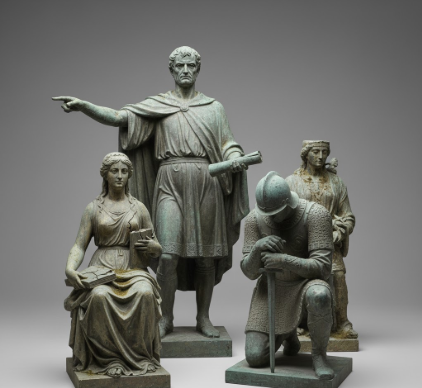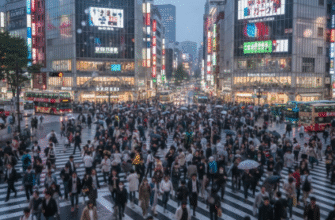Walk through any city, and you’ll find them. Silent figures cast in bronze, carved from stone, standing watch over bustling squares and quiet parks. We rush past them on our way to work, we use them as meeting points, but how often do we truly
see them? These statues are more than just landmarks or public art; they are time capsules, dense with stories, secrets, and the forgotten whispers of history. They are the city’s collective memory, frozen in place, waiting for a curious eye to decipher their language.
At first glance, a statue of a historical figure seems straightforward—a tribute to a general, a politician, an artist. Yet, every element is a deliberate choice, a piece of a carefully constructed narrative. The material itself speaks volumes. Marble evokes classical grandeur and purity, linking the subject to the timeless ideals of ancient Greece and Rome. Bronze, durable and resilient, suggests permanence and strength, a legacy meant to withstand the ages. The very pose of the figure is a sentence in this silent dialogue. Is the subject on horseback, a symbol of conquest and command? Are they seated, deep in thought, inviting contemplation? Every gesture, every fold in the fabric of their clothing, is part of the story the sculptor and the patrons wanted to tell.
Beyond the Heroic Pose
To truly understand a monument, one must look beyond the central figure. Often, the most compelling narratives are found at the base, in the reliefs and inscriptions that adorn the pedestal. Here, you might find scenes depicting the subject’s greatest achievements, allegorical figures representing virtues like Justice or Wisdom, or the names of battles fought and won. These details provide context, fleshing out the one-dimensional hero into a more complex historical actor. They reveal what the society of that era chose to celebrate and what they deemed worthy of immortalization.
The location of a statue is another crucial chapter in its story. A monument placed in the heart of a city’s government district makes a powerful statement about national identity and authority. One tucked away in a university campus speaks to a legacy of knowledge and learning. Over time, as cities evolve, these locations can change, adding new layers of meaning. A once-prominent statue might find itself overshadowed by modern skyscrapers, a poignant reminder of the relentless march of time and the shifting priorities of urban life.
It’s crucial to remember that a statue often represents the perspective of the powerful—those who had the resources and influence to commission such a work. The story it tells is almost never the complete one. It is a curated version of history, polished and presented to reflect the values of a specific time and social class.
When Stone and Bronze Spark Debate
Not all stories told by statues are celebratory. In fact, many monuments have become focal points for controversy and intense public debate. Figures once revered as heroes are now seen through a different lens, their legacies re-examined in light of modern ethics and a more inclusive understanding of history. Statues of colonial governors, Confederate generals, or controversial monarchs force us to confront uncomfortable truths about our past.
These debates are not about erasing history. Instead, they are about acknowledging that history is not a single, static story. It is a living, breathing thing, constantly being reinterpreted. The controversy surrounding a statue is, in itself, a new story being written. The protests, the calls for removal, the addition of new plaques that provide a more balanced context—all of these actions add to the monument’s ongoing narrative. They show a society grappling with its own identity and struggling to decide which values it wants to carry into the future.
The Voices of the Unseen
Perhaps the most moving urban monuments are not those dedicated to the great and powerful, but those that honor the anonymous. Look closely, and you might find statues celebrating the common worker—the miner, the farmer, the factory laborer—whose toil built the city. You might discover monuments that memorialize the victims of a tragedy, giving a face to collective grief and resilience. These statues tell a different kind of story. They speak of shared experience, of community, of the quiet dignity of ordinary lives.
These memorials serve as powerful reminders that history is not just made by kings and generals. It is shaped by the countless contributions of everyday people. They ensure that the sacrifices and struggles of the masses are not forgotten, providing a more democratic and human-scale counterpoint to the grand narratives of national heroes. They invite us to reflect on our own connection to the city’s past and the shared humanity that binds us all.
Many people believe there’s a secret code in equestrian statues regarding the horse’s legs. The popular myth states that if one hoof is raised, the rider was wounded in battle, and if two are raised, the rider died in battle. While this pattern holds true for some famous monuments, historians have debunked it as a widespread, intentional rule; the pose is more often an artistic choice by the sculptor.
So, the next time you find yourself in a city square, take a moment. Pause before one of those silent, weathered figures. Look beyond the name on the plaque. Study the pose, the expression, the details carved into the stone base. Ask yourself: Who built this, and why? What story did they want to tell? And what story does it tell
you, today? You might be surprised to find that the silent statues have the most profound stories to share, a constant, evolving conversation between the past and the present, waiting for anyone willing to listen.









